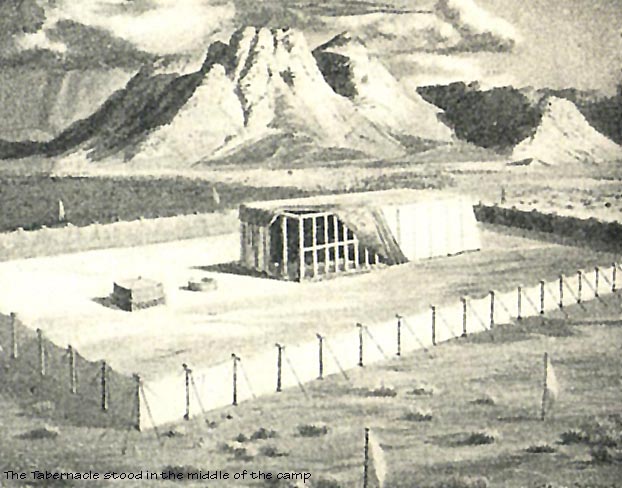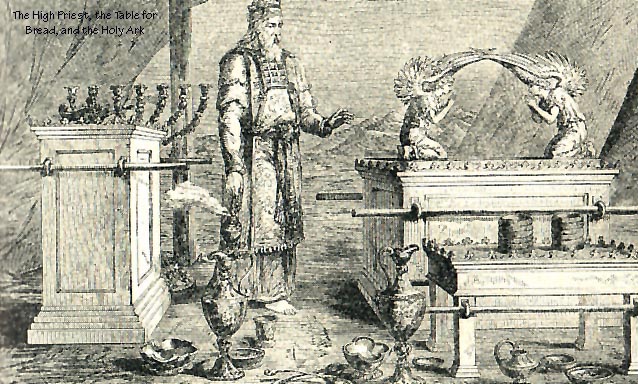
Stories From The Hebrew Bible
THE TENT WHERE GOD LIVED AMONG HIS PEOPLE

Stories From The Hebrew Bible
THE TENT WHERE GOD LIVED AMONG HIS PEOPLE
It may seem strange that the Israelites would fall away from the service of God to the worship of idols (as we learned in our last story), especially after all that God had done for them, and while Mount Sinai was still showing God’s glory. But we need to keep in mind that all the people whom the Israelites had lived among and served in Egypt, were worshipers of images. Many people in those times felt that they needed gods they could see.
God was very good to the Israelites after they had forsaken Him, because He took them back again as His own people; and God gave to the Israelites a plan for worship, which would allow them to have something that they could see to remind them of their God; and yet at the same time, would not lead them to the worship of an image, but would teach them a higher truth, that the true God cannot be seen by the eyes of men.
The plan was this: to have in the middle of the camp of Israel a Tabernacle to be called the “Tent of Meeting,” which the people could see and to which they could come for worship. Every time that an Israelite looked at this house he could say to himself and teach his children, “That is the house where God lives among His people,” even though no image stood in the house.
And since the Israelites were living in tents and were often moving from place to place, the Tent of Meeting needed to be something like a tent, so that when the camp was changed, it could be taken down and moved. Such a tent as this was called a Tabernacle. The Tabernacle then was the tent where God lived among the people, and where the people could meet God.
We know that God is a Spirit and has no body like ours; and that He is everywhere.

Yet it was right to say that God lived in the Tabernacle of the Israelites, because there God showed His presence in a special way, by having the pillar of cloud over it all day and the pillar of fire all night.
In the wilderness, this Tabernacle stood exactly in the middle of the camp of the Israelites. In front of it, and a little distance from it, on the east, stood the tents where Moses and Aaron lived, and from which they gave the laws and commands of God to the people (see Num. 3:38).
Around the Tabernacle there was an open space; about a hundred and fifty feet long by seventy-five feet wide. In other words, its length was twice its width. Around it was a curtain of fine linen, in bright colors, hanging upon posts of brass. The posts were held in place by cords fastened to the ground with tent spikes or stakes. The open space was called the Court of the Tabernacle. The curtain around it was a little higher than a man’s head, between seven and eight feet. In the middle, on the end toward the east, it could be opened for the priests to enter into the court. Only the priest and their helpers were ever allowed to enter it.
The great Altar stood inside this court, near the entrance. Do you remember? An altar was made either of stone or by heaping up the earth. It was the place on which a fire was built to burn the offering or sacrifice. Do you also remember? The offering or sacrifice was the gift offered to God whenever a man worshiped; it was given to God by being burned upon His altar.
But since a stone or earth altar could not easily be carried from place to place, God told the Israelites to make an altar of wood and brass or copper. It was like a box, without bottom or top, made of thin boards, perhaps so that it would not be too heavy, and then it was covered on the inside and the outside with plates of brass or copper, so that it would not burn up when the fire was kindled. Inside, a few inches below the top, was a metal grating on which the fire was built; and the ashes would fall through the grating to the ground inside.
This altar had four rings on the corners, through which long poles were placed, so that the priests could carry it on their shoulders when the camp was moved. The altar was a little less than five feet high and little more than seven feet wide on each side. This was the great altar, sometimes called “The Altar of Burnt Offering,” because a sacrifice was burned upon it every morning and every evening. The Laver stood near the altar in the court of the Tabernacle. The Laver was a large tank, or basin, holding water that was used to wash the offerings. Lots of water was needed for Tabernacle worship; and so the Laver was kept full of water.
The Tabernacle was a large tent and itself stood in the court. It was larger and being God’s tent, it was also more special than the ones used by the people on their journey through the wilderness. Therefore, the walls of the Tabernacle were not made of skins or woven cloth like those of the people, but it was made of boards standing upright on silver bases and fastened together. The boards were covered with gold. The roof of the Tabernacle was made of four curtains. One curtain laid above another. The inner curtain was beautifully decorated. The outer curtain was made of rams’ skins to keep out the rain. The board walls of the Tabernacle were on the two sides and the rear end. The front was open, except when a curtain was hung over it. The Tabernacle was half tent and half house. It was about forty-five feet long, and fifteen feet wide, and fifteen feet high. Its only floor was the sand of the desert.
This Tabernacle was divided into two rooms by a veil which hung down from the roof. The larger room, the one on the eastern end, into which the priest came first from the court, was twice as large as the other room. It was thirty feet long, fifteen feet wide, and fifteen feet high, and was called the Holy Place. In the Holy Place were three things: on the right side, as one entered, a table covered with gold, on which lay twelve loaves of bread, as if each tribe gave its offering of food to the Lord; on the left side, the Golden Lampstand, with seven branches, each having its light. This is sometimes called the Golden Candlestick, but as it held lamps and not candles, it could have been called “the Lampstand.”
At the furtherest end of the Holy Place, close to the veil, was the Golden Altar of Incense. This was a small altar on which fragrant gum was burned and from which a silvery cloud floated up. The fire on this altar was always to be lighted from the great altar of brass or copper that was standing outside the Tabernacle in the court. Everything in this room was made of gold or covered with gold, even to the walls on each side.
The inner room of the Tabernacle was called the Holy of Holies; and it was so sacred that no one except the high priest ever entered it, and he only one day a year. The Holy of Holies was fifteen feet wide, fifteen feet long, and fifteen feet high. All that it held was a box or chest, made of wood and covered with plates of gold on both the outside and the inside. It had a cover of solid gold, on which stood two strange figures called cherubim, also made of gold. This chest was called the Ark of the Covenant. In it, for safe keeping, were placed the two stone tablets on which God wrote the Ten Commandments. It was in the Holy of Holies that God dwelt and revealed His glory. But in it there was no image to tempt the Israelites to worship idols.

Whenever the camp was to move and to be changed, the priests would first carefully cover all the furniture in the Tabernacle with curtains.
They covered the Table, the Lampstand, the Altar of Incense, and the Ark of the Covenant. They also passed rods through the rings which were on the corners of all these articles. They took down the Tabernacle, its great curtains, its posts and its pillars. Then the men of the tribe of Levi, who helped the priests, took up their burdens and carried them in front of the camp. The twelve tribes were arranged in marching order behind them; the Ark of the Covenant unseen under its wrappings, carried upon the shoulders of the priests by rods, led the way, with the pillar of cloud over it. In this way the children of Israel moved their camp from place to place for forty years in the wilderness.
Each time they stopped to make camp, the Tabernacle was set up first; the court around it and the altar in front of it. Then the tribes placed their tents in order around it, three tribes on each of its four sides.
And whenever an Israelite saw the altar with the smoke rising from it and the Tabernacle with the silver-white cloud above it, he was no doubt touched by the splendor of God.